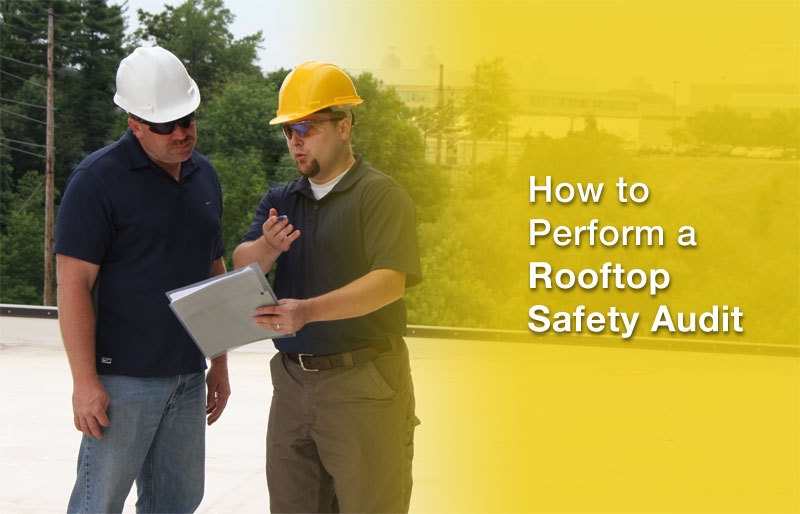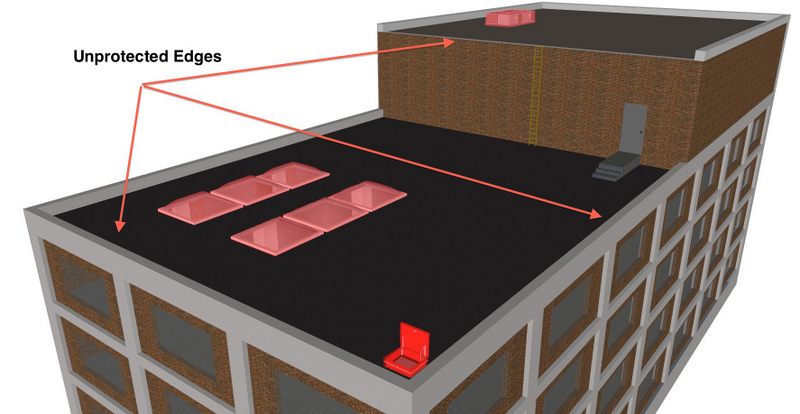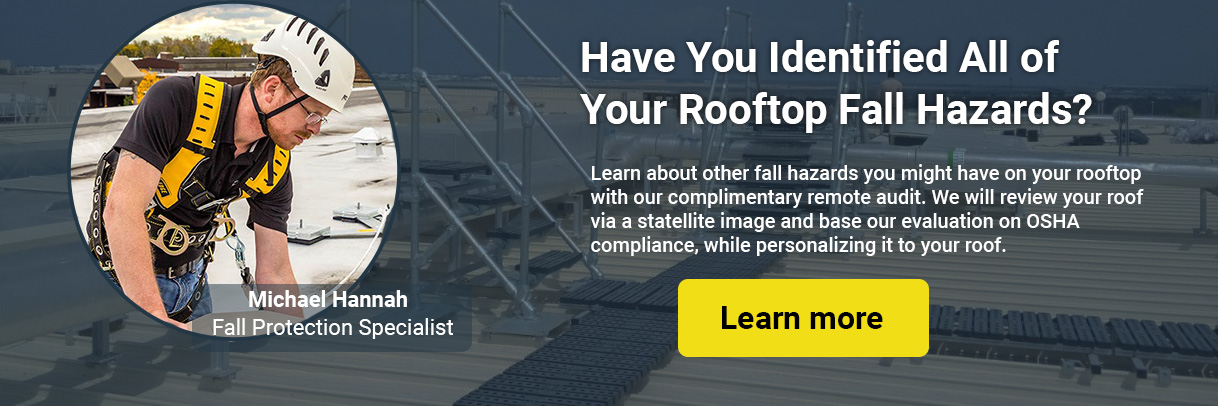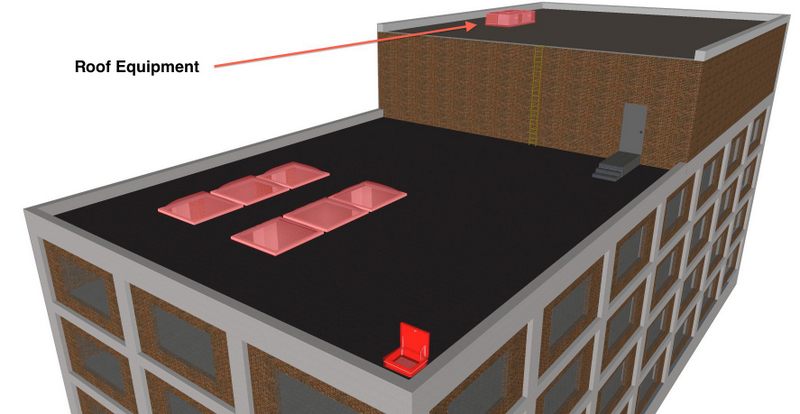How to Perform a Rooftop Safety Audit

Falls from height are still a primary killer when it comes to workplace fatalities. The rooftop is the most common area where general industry employees are exposed to a fall hazard. Roof access is not necessarily an everyday part of someone's job, so its easier to ignore the safety hazards that exist. Consider the following activities that take place on the roof:
- Maintenance and Repair of HVAC Equipment
- Servicing of Security and Surveillance Equipment
- Gutter Cleaning
- Snow Removal
- Window Washing Preparation
A business with a Safety First mindset will perform a hazard assessment in every area of their business, and the rooftop is no exception. Below are the primary areas to consider when auditing the safety of a rooftop. Of course, every roof has its own nuances, but these are the principal areas that will help to ensure people are kept safe when accessing the roof.
1. Access Points

The first thing to look for in your roof safety audit is how people access the roof. There are four common ways that people tend to access the roof:
- Roof Hatches
- Walk Out Doors
- Exterior Stairs and Ladders
Here are some common considerations for each of these areas.
- Are there railings around the roof hatch? When the hatch is open, it is a hole in the roof.
- Is the hatch dangerously close to a roof edge?
- Are there any trip hazards around walk-out doors?
- Are permanently attached ladders in good repair? The ladder should be rust free and securely attached to the wall.
- Are there self-closing gates on access points such as hatches and ladders?
- If people are accessing the roof at night, is proper lighting in place?
- Are access points properly secured? Ensure that access doors remain locked and that exterior stairs cannot be accessed by an unauthorized person.
2. Unprotected Edges and Open Sides

The roof edge is probably the most obvious fall hazard that exists on a roof. This is where people expect a hazard, but the following should be considered:
- Are there any changes in height (roof to roof) that are greater than four feet? If so, these need to be protected.
- Are the edges that are being worked around or walked past properly guarded?
- Are parapets that are shorter than 42" properly guarded?
- Are existing fall protection railings or fall arrest devices in proper working order?
- Is there toeboard in place to prevent tools from being kicked over the edge? Be sure to be familiar with when you need to use toeboard.
There are a number of different options for protecting a roof edge. The safest option is always eliminating the hazard completely. This can be done by installing complete perimeter protection with a roof guardrail. In many cases, this is not possible or practical.
If that is the case, apply spot protection by identifying the areas of the roof that pose direct hazards to employees and contractors. These areas are typically anywhere a roof edge is near a working or walking surface.
If a railing is not possible, horizontal life lines and personal fall protection can be used to provide fall protection while working near the roof edge.
Be sure to check out the pros and cons of every fall protection system before deciding which fall protection method should be used.

3. Walking Paths

When it comes to the roof, the shortest distance between two points may not be the safest! People typically want to go the fastest route from point A to point B. When considering rooftop safety, the A to B direct route may not be the safest option. It may be safer to direct someone along a marked route to keep them from walking close to a hazard.
- Are safe walking paths on the roof clearly demarcated? If you are in a climate that gets snow will people be able to discern the path when there is snow on the roof?
- Does the walking path have to cross any rooftop obstacles such as pipes or varying height roofs?
- Does the walking path get closer than 15' to an unprotected roof edge?
- Does the roof surface become especially slippery in certain kinds of weather?
- Are people required to walk on an uneven roof surface? (e.g. standing seam or rib roofs)
Properly demarcating a walkway and providing a level walking surface can significantly reduce the risk of falling
The walking path needs a risk assessment just as much as the area where work is being performed. If you are not sure what path employees and contractors are taking, look for footprints – you may be surprised where workers are walking on your roof.
4. Rooftop Equipment

People are accessing the roof for a reason. Most of the time, it is to access a piece of equipment. HVAC equipment, fans, sensors, and other roof top units are commonly located on the roof and are constantly in need of servicing and repair. You may be under the assumption that it is the contractors' responsibility to protect themselves while working on your roof, but OSHA and your lawyer will tell you that you also have a duty to protect. So even if your equipment is being serviced by a contractor, here are some important questions to ask about your rooftop equipment:
- What equipment needs to be accessed on the rooftop?
- Is any of the equipment within 15' of the roof edge? If so, OSHA requires that railing be present to protect the worker from a fall hazard.
- Is it possible to fall INTO or THROUGH the equipment?
- Does accessing the equipment pose a significant trip hazard?
- Is the equipment taller than 6'? If so, is the worker protected if they need to access the top of the equipment?
5. Openings

It may sound strange to think that you have openings in your roof. After all the primary function of the roof is to provide a covering from the rain and elements. If it has an opening, then its difficult for a roof to do its job! However, there are openings in the roof that many people do not consider until doing a roof safety audit.
- Are all skylights properly guarded? Contrary to what you might think, OSHA considers your skylight to be a hole in your roof!
- Are smoke vents properly guarded? Smoke vents are not necessarily made to be stepped on and carry the weight of an adult. These can be a dangerous hazard if not properly guarded. Your local fire marshal may require you to protect smoke vents in the open position to protect fire personnel accessing your roof in the case of a fire.
- Are roof hatches properly guarded? This one was mentioned in the access section as well. An open roof hatch is a genuine fall hazard.
- Are there smaller openings for tools or equipment to fall into? Its important that no one can be injured from a falling tool.
Other Considerations
This rooftop safety audit has focused on fall hazards on the rooftop because they propose a significant threat to someone's life. There are other hazards that need to be considered as well when examining the rooftop.
- Hazardous Materials - Are there any hazardous materials that vent or collect on the roof surface?
- Weather Conditions - Different roof surfaces respond differently in varying conditions. It should be clearly communicated what the weather conditions must be in order to access the roof.
- Controlled Access - Who will be allowed to access the roof? Will people be accessing the roof alone? Is there a log in place to track the presence of people coming on and off the roof? Is there a radio check-in system to ensure that an accident has not occurred?
- Fall Protection Plan - A safety plan is not optional when accessing the roof? Do you have the required work at height safety policy that includes a rescue plan?
- Unique Situations - What hazards are unique to your rooftop?
This article is intended to be a helpful start to your rooftop safety audit. There will always be additional hazards that fall outside the scope of what has been written here. Be sure that a competent person is evaluating the safety of your rooftop. Our team is available for consultation and can provide further direction for your particular roof.


